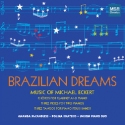Brazilian Dreams reflects what may seem an unpredictable turn in the creative activity of an American composer born in California and living in Iowa. Concerned throughout my earlier career with writing in a modernist, post-tonal idiom, I gradually found myself on a musical itinerary that led me to write in the style of chôro, a music from a country I have never seen. A genre of Brazilian popular music that developed in Rio de Janeiro in the late nineteenth century, chôro has its roots in a performance style for social dances such as the polka, mazurka, waltz, and maxixe, combining harmonic and formal features of European music with Afro-Brazilian rhythms. Beginning with a trio of guitar, cavaquinho (a relative of the ukulele) and flute, chôro ensembles expanded to include the pandeiro (a Brazilian tambourine), and seven-string guitar. The latter provided a bass line, improvised as a counterpoint to the tune played by the lead instrument, typically flute or bandolim (the Brazilian mandolin). For American listeners, chôro may seem reminiscent of traditional New Orleans jazz in emphasizing ensemble improvisation, and of ragtime in its emphasis on syncopation. Flourishing during the 1920s and 1930s, chôro was marginalized in the 1950s and 60s by American musical imports and the rise of bossa nova, but underwent a revival in later decades.
The classically-trained pianist Ernesto Nazareth (1864-1934) brought the chôro idiom to the keyboard, and in turn many of his “Brazilian tangos” later became part of the popular chôro ensemble repertoire. Among other Brazilian classical composers, Heitor Villa-Lobos and Radames Gnattali composed chôro-inspired art music for concert performance. Most of the music on this CD could be called “erudite chôro,” a term denoting chôro composed for concert performance by instruments associated with European classical music.
In the fall of 2006 Maurita Murphy Mead (now Maurita Murphy Marx), professor of clarinet at the University of Iowa, asked me to compose a chôro-style piece for her and the Brazilian pianist Rafael Dos Santos, who earned MM and DMA degrees at Iowa in the 1990s, and is professor of piano at the Universidade Estadual de Campinas, near São Paulo. On Mead’s 1998 CD of chôro music Over the Fence, Rafael had improvised piano accompaniments sensitively capturing the balance and articulation of a chôro ensemble. Captivated by this recording, and drawing on my acquaintance with Ernest Nazareth’s piano pieces (first encountered in the mid-1980s through Arthur Moreira Lima’s recordings), I wrote Luz e Sombra (“Light and Shadow”). Mead and Dos Santos first played it in December 2006 on a KSUI-FM radio broadcast from the University of Iowa Museum of Art, and subsequently in a concert commemorating the centennial of the UI School of Music. In early 2007 I added Rebote (“Rebound”) and Diálogo (“Dialogue”) to make a set of three pieces, and later that year composed Three Pieces in Brazilian Style. Three for the Road followed in 2008, and Three Scenes in 2010. The titles of Three for the Road (2008) refer to a VW once owned by Maurita Mead, and to driving, slow and fast. “Garden Ramble” in Three Scenes refers to the floral and herb gardens created by my wife Mary Lynn every spring and summer. Amanda McCandless and Polina Khatsko gave the first concert performance of Three Scenes on March 28, 2015, at an Iowa Composers Forum festival at the University of Northern Iowa.
The starting point for Three Tangos was Tango Piccolo, a miniature Argentine tango: I wrote a first version of this piece in the mid-1990’s for my son Adam to play in a group recital of fourhand music. Tango Passacaglia—a series of contrapuntal variations, with a repeating tune heard in various registers—followed in 2002, and Tango Cromatico in 2006; both are Brazilian tangos inspired by those of Ernesto Nazareth. Ketty Nez and Réne Lecuona gave the first integral performance of Three Tangos at Boston University in September 2006. The Unison Duo first played it on an October 2009 recital tour sponsored by the Iowa Composers Forum. Written in 2011-12, Three Pieces for Two Pianos is dedicated to the Unison Piano Duo, who premiered it in February 2012 at Luther College. The lyrical episode that frames the first piece was inspired by the mood of Jimmy Van Heusen’s 1939 tune “I Thought About You,” a jazz standard. The second piece is a neo-Baroque passacaglia, though with some stylistic detours; the third is in chôro style. [Michael Eckert, June 2015]
Michael Eckert is professor of music theory and composition at The University of Iowa School of Music, where he has been on the faculty since 1985. He previously taught at Colorado State University, the University of North Carolina at Chapel Hill, Tulane University, and Antioch College. A native of northern California, he studied composition with John Richard Ronsheim at Antioch College, and with Ralph Shapey at the University of Chicago. His awards for composition include the Bearns Prize from Columbia University, a Charles E. Ives Scholarship from the National Institute of Arts and Letters, a National Endowment for the Arts fellowship, and the Music Teachers National Association Distinguished Composer of the Year Award. His Echo’s Song won second prize in the 2006 New York Virtuoso Singers choral composition competition, and is recorded on Albany Records by the University of Iowa Kantorei.
